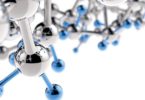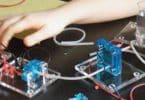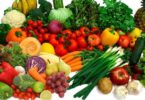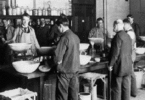Which of the following is least effective in photosynthesis?
(a) Sun light
(b) Red light
(c) Blue light
(d) Green light
Dark reactions of photosynthesis occur in
(a) Granal thylakoid membranes
(b) Stromal lamella membranes
(c) Stroma outside photosynthetic lamellae
(d) Periplastidial space
Dark reaction of photosynthesis occurs in the
(a) Membrane of the stroma lamellae
(b) Stroma of the chloroplast outside the lamellae
(c) Space between the two membranes of the chloroplast
(d) Thylakoid membrane of grana
The process of photosynthesis is caused by
(a) Carbon dioxide
(b) Water
(c) Chlorophyll
(d) All the above
Which of the following is CO2 acceptor in C4 plants?
(a) Phosphoenol pyruvate
(b) Ribulose 1, 5 diphosphate
(c) Oxaloacetic acid
(d) Phosphoglyceric acid
Related: MCQ on Biomass Energy
In photosynthesis, a compound belonging to which of the following families is formed ?
(a) Protein
(b) Fat
(c) Carbohydrate
(d) Vitamin
Oxygen containing carotenoids are
(a) Carotenes
(b) Xanthophylls
(c) Anthocyanins
(d) Phycobilins
Most enzymes involved in respiration and photosynthesis are made up of carbon, hydrogen and the following
(a) O2, N and S
(b) P and S
(c) Fe and Mn
(d) Cu and Mo
Which of the following is the correct statement?
(a) heterotrops synthesize their own food
(b) heterotrops utilize solar energy for photosynthesis
(c) heterotrops do not synthesize their own food
(d) heterotrops are capable of converting carbon dioxide and water into carbohydrates.
Photorespiration occurs in
(a) Mitochondria
(b) Ribosomes
(c) Peroxisomes
(d) Lysosomes
Related: Biotechnology and its Applications Biology Objective Questions
Which of the following cells of C4 plants is prominently loaded with starch :
(a) Epidermal cells
(b) Mesophyll cells
(c) Bundle sheath cells
Which of the following plants shows chloroplast dimorphism?
(a) Wheat
(b) Rice
(c) Sugar beet
(d) Sugarcane
The first product of photorespiration is
(a) Phosphoglycolate
(b) Glycolate
(c) Glycerin
Complete girdling ultimately kills the tree due to
(a) Starvation of root
(b) Stoppage of photosynthesis
(c) Nonmovement of minerals
(d) Nonmovement of water.
The core metal of chlorophyll is
(a) Cu
(b) Mg
(c) Fe
(d) Ni
Related: Work and energy questions (practice)
First stable product of C4 cycle :
(a) Oxaloacetic acid
(b) Citric acid
(c) Succinic acid
(d) Fumeric acid
ATP formation during photosynthesis is
(a) Phosphorylation
(b) Photophosphorylation
(c) Oxidative phosphorylation
(d) None of these
Photosynthetic pigments found in the chloroplasts occur in
(a) Thylakoid membranes
(b) Plastoglobules
(c) Matrix
(d) Chloroplast envelope
Chlorophylls absorb visible light of wavelengths
(a) 400-500 nm only
(b) 300-400 nm only
(c) 600-800 nm only
(d) 400-500 nm and 600-700 nm
The law of limiting factors for photosynthesis was enunciated by
(a) R. Hill
(b) Calvin
(c) Krebs
(d) Blackman
Related: Questions on Satellite Communication
Photorespiration is favored by
(a) High oxygen and low carbon dioxide
(b) High carbon dioxide and low oxygen
(c) High temperature and low oxygen
(d) High humidity and temperature
Translocation of carbohydrate nutrients usually occurs in the form of
(a) Glucose
(b) Maltose
(c) Starch
(d) Sucrose
ATP is
(a) Adenine triphosphate
(b) Adenosine tetraphosphate
(c) Adenosine triphosphate
(d) Adenine tetraphosphate
Kranz anatomy occurs in
(a) Leaves
(b) Stem
(c) Flower
(d) Seed
Related: tongue questions and answers
Calvin’s cycle is
(a) Dependent upon light
(b) Independent of light
(c) Supported by light
(d) Hindered by light
The condition favoring cyclic photophosphorylation is
(a) Anaerobic environment
(b) Aerobic and low light intensity
(c) Aerobic and optimum light
(d) Anaerobic and low light intensity
What is true for photosynthesis ?
(a) Both carbon dioxide and water are oxidized
(b) Both carbon dioxide and water are reduced
(c) Carbon dioxide is oxidized and water reduced.
(d) Carbon dioxide is reduced and water oxidized
Light energy is converted into chemical energy in the presence of
(a) Chloroplasts
(b) Pyrenoids
(c) Ribosomes
(d) Mesosomes
Which element requires photosynthetic evolution of oxygen ?
(a) Cu
(b) Fe
(c) Zn
(d) Mn
Related: Acceleration Due to Gravity (Physics) Question Papers and Answer
A special feature of C4 plants is
(a) Thin cuticle
(b) Multilayered epidermis
(c) Kranz anatomy
(d) Both (a) and (b)
Which one is product in respiration and reagent in photosynthesis ?
(a) O2
(b) CO2
(c) CO
(d) N2
Plants purify air during
(a) Photosynthesis
(b) Respiration
(c) Transpiration
(d) Desiccation
Maximum starch is manufactured by
(a) Spongy parenchyma
(b) Palisade parenchyma
(c) Guard cells
(d) Vascular tissue
In C4 plants, carbon dioxide fixation occurs in chloroplasts of
(a) Palisade tissue
(b) Spongy parenchyma
(c) Guard cells
(d) Hypodermis and chlorenchyma
Related: Radioactivity (Chemistry) question paper
In C4 plants, synthesis of sugars/final CO2 fixation occurs in
(a) Undifferentiated mesophyll cells
(b) Bundle sheath cells
(c) Epidermal cells
(d) Spongy cells
The autumn coloration of leaves is precisely due to
(a) Zeaxanthin
(b) Violaxanthin
(c) Neoxanthin
(d) All of these
One of the common Hill reagents is
(a) Benzoquione
(b) Plastoquinone
(c) Ferredoxin
(d) Plastocyanin
If the concentration of oxygen is increased, the photosynthetic rate decreases and the phenomenon is called as
(a) Emerson effect
(b) Blackman effect
(c) Pasteur effect
(d) Warburg effect
The greatest producers of organic matter are
(a) Crop plants
(b) Forests
(c) Plants of the land area
(d) Phytoplankton of oceans
Related: Oxidation and reduction questions
The dark reaction of photosynthesis is
(a) Hill reaction
(b) Calvin cycle
(c) Cyclic photophosphorylation
(d) N oncyclic photophosphorylation
Photolithotrophs (photoautotrophs) obtain energy from
(a) Radiation and carbon from inorganic compounds
(b) Radiation and carbon from organic compounds
(c) Organic compounds
(d) Inorganic compounds
ATP formation in chloroplasts and mitochondrion is explained by
(a) Cholodny-Went model
(b) Chemi-osmotic theory of Mitchell
(c) Munch’s mass flow theory
(d) Relay pump theory of Godlewski
Energy from a light reaction is transferred to the dark reaction in the form of
(a) ADP
(b) ATP
(c) Chlorophyll
(d) RuBP
Related: Medical general knowledge quiz
The site for light reaction is
(a) Grana
(b) Stroma
(c) ER
(d) Cytoplasm
Nine-tenths of all photosynthesis in the world (85-90%) is carried out by
(a) Large trees with millions of branches and leaves
(b) Algae of the ocean
(c) Chlorophyll containing ferns of the forest
(d) Scientists in the laboratories
In which of the following groups of organisms the food material is broken down outside the body as absorbed?
(a) Mushrooms, green plants, Amoeba
(b) Yeast, mushroom, bread mold
(c) paramecium, Amoeba, Cuscutta
(d) Cuscuta, Lice, Tapeworm
The opening and closing of the stomatal pores depends upon:
(a) oxygen
(b) water in guard cells
(c) temperature
(d) concentration of CO2 in the stomata
Which of the following events does not occur in photosynthesis?
(a) conversation of light energy into chemical energy
(b) reduction of carbon dioxide to carbohydrates
(c) oxidation of carbon to carbon dioxide
(d) absorption of light energy by chlorophyll
Related: mcqs on algae
When carrying out the starch test on a leaf, why is it important to boil the leaf in alcohol?
(a) to dissolve the waxy cuticle
(b) to make the cells more permeable to iodine solution
(c) to remove the chlorophyll
(d) to stop chemical reactions in the cells







quite understandable